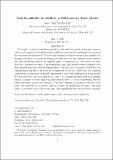Files in this item
Nash equilibrium in tariffs in a multi-country trade model
Item metadata
| dc.contributor.author | Chattopadhyay, Subir | |
| dc.contributor.author | Mitka, Malgorzata M. | |
| dc.date.accessioned | 2021-02-13T00:39:20Z | |
| dc.date.available | 2021-02-13T00:39:20Z | |
| dc.date.issued | 2019-10 | |
| dc.identifier | 260661316 | |
| dc.identifier | 84ce140e-76cf-4729-a921-e293d510f2cf | |
| dc.identifier | 85071762391 | |
| dc.identifier | 000488145200021 | |
| dc.identifier.citation | Chattopadhyay , S & Mitka , M M 2019 , ' Nash equilibrium in tariffs in a multi-country trade model ' , Journal of Mathematical Economics , vol. 84 , pp. 225-242 . https://doi.org/10.1016/j.jmateco.2019.07.011 | en |
| dc.identifier.issn | 0304-4068 | |
| dc.identifier.other | ORCID: /0000-0001-9828-3843/work/62668462 | |
| dc.identifier.uri | https://hdl.handle.net/10023/21424 | |
| dc.description.abstract | We study a general equilibrium model of trade with two goods and many countries where each country sets its distortionary tariff noncooperatively to maximize the payoff of the representative household. We prove the existence of pure strategy Nash equilibria by showing that there are consistent bounds on tariff rates that are common across countries and that payoff functions in the induced game are quasiconcave. Separately, we show that best responses are strictly increasing functions, and provide robust examples that show that the game need not be supermodular. The fact that a country’s payoff does not respond monotonically to increases in a competitor’s tariff rate, shows that the standard condition in the literature for payoff comparisons across Nash equilibria fails in our model. We then show that the participation of at most two countries in negotiated tariff changes suffices to induce a Pareto improving allocation relative to a Nash equilibrium. Further results provided concern the location of the best response in relation to the free trade point, the monotonicity of payoffs, and the bounds on equilibrium strategies. The final result is that there is no trade if and only if the equilibrium allocation is Pareto optimal. | |
| dc.format.extent | 451923 | |
| dc.language.iso | eng | |
| dc.relation.ispartof | Journal of Mathematical Economics | en |
| dc.subject | Retaliatory tariffs | en |
| dc.subject | Multi-country | en |
| dc.subject | Pure strategy | en |
| dc.subject | Nash equilibrium | en |
| dc.subject | HB Economic Theory | en |
| dc.subject | T-NDAS | en |
| dc.subject.lcc | HB | en |
| dc.title | Nash equilibrium in tariffs in a multi-country trade model | en |
| dc.type | Journal article | en |
| dc.contributor.institution | University of St Andrews. School of Economics and Finance | en |
| dc.identifier.doi | 10.1016/j.jmateco.2019.07.011 | |
| dc.description.status | Peer reviewed | en |
| dc.date.embargoedUntil | 2021-02-13 |
This item appears in the following Collection(s)
Items in the St Andrews Research Repository are protected by copyright, with all rights reserved, unless otherwise indicated.

